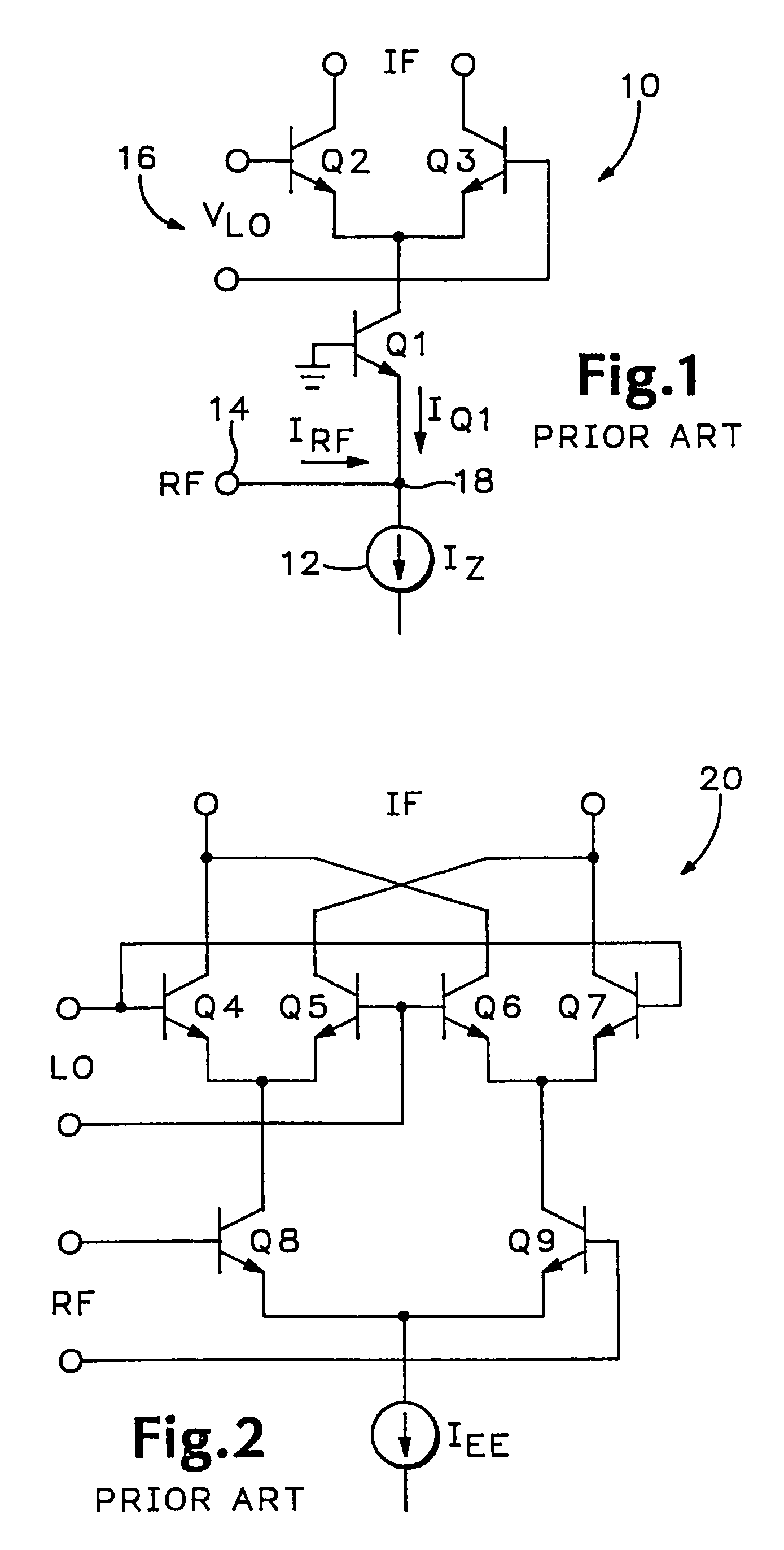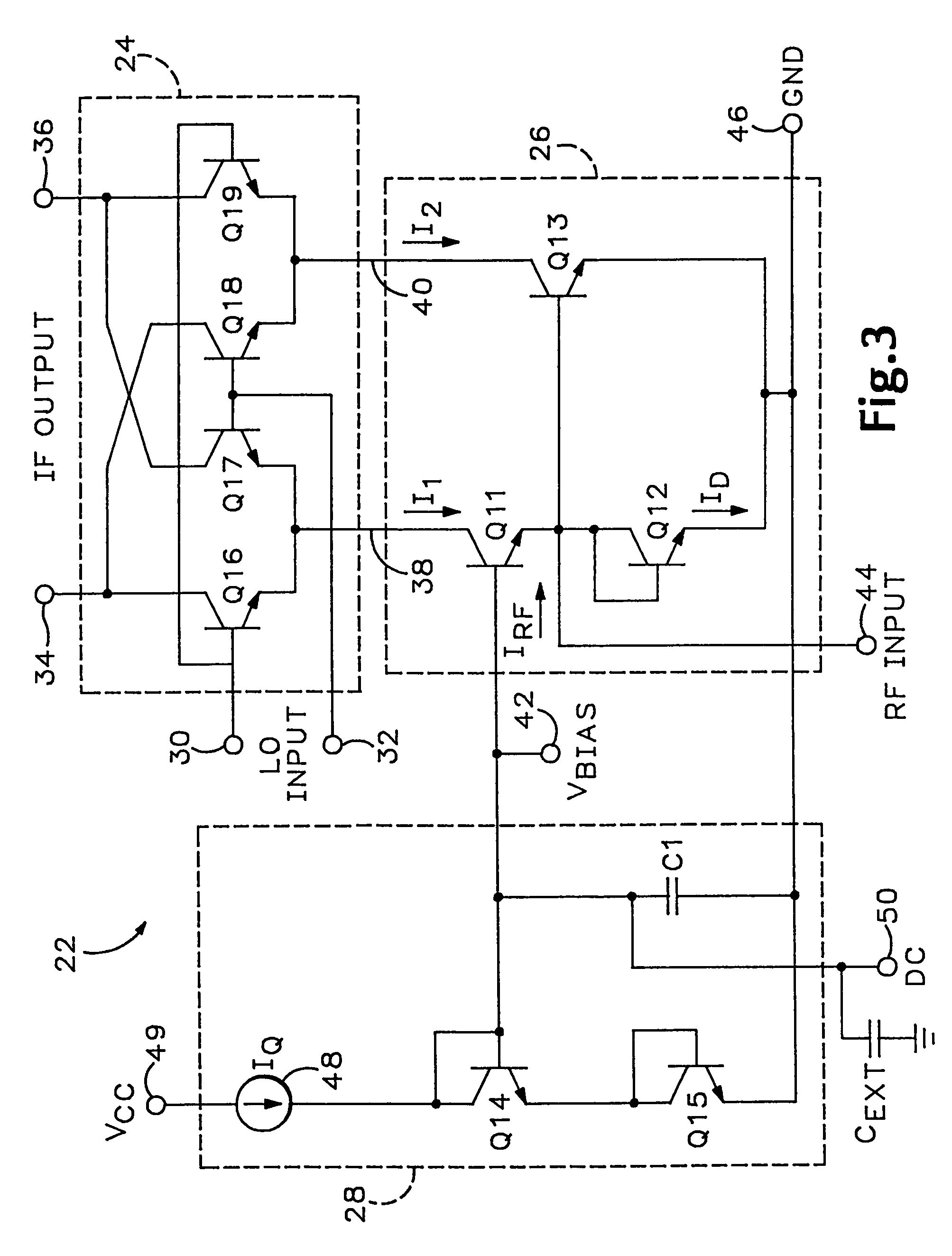RF mixer with inductive degeneration
a technology of inductive degeneration and mixer, which is applied in the field of analog circuits, can solve the problems of nonlinear relationship between the input current isub>q1 /sub>and the input current isub>rf /sub>, and the output signal produces unacceptable levels of intermodulation distortion, and a separate notch or band stop filter is needed, so as to achieve further noise reduction, the effect of extending the dynamic range and reducing nois
- Summary
- Abstract
- Description
- Claims
- Application Information
AI Technical Summary
Benefits of technology
Problems solved by technology
Method used
Image
Examples
second embodiment
[0054]Referring now to FIG. 4, the biasing circuit 28 is shown. This embodiment includes a proportional to absolute temperature (PTAT) cell, shown generally at 52, an operational amplifier 54, and a filter shown generally at 56. The PTAT cell 52 includes transistors Q20 and Q21 along with resistors R1, R2 and RBIAS. The emitter areas of transistors Q20 and Q21 have a predetermined relationship. As shown in FIG. 4, the emitter area (Me) of transistor Q21 is M times the emitter area (e) of transistor Q20. It can readily be shown that this ratio produces a current (IQ21) through the resistor RBIAS given by the following expression:
IQ21=(VT / RBIAS)×lnM
where VT is the thermal voltage (kT / q), which is approximately equal to 26 mV at 300° K. This current IQ21 is thus proportional-to-absolute-temperature (PTAT).
[0055]The bases of transistors Q20 and Q21 are coupled to the RF input 44 via the filter 56. The filter 56, comprised of resistor R3 and capacitor CF, removes the RF signal and passes...
third embodiment
[0056]the biasing circuit, shown in FIG. 5, adds two additional diodes D1 and D2 to the biasing circuit of FIG. 4. By using the diodes D1 and D2, the biasing circuit 28 can be decoupled from the RF input 44. Thus, the filter (resistor R3 and capacitor CF) of FIG. 4 is no longer required. The biasing circuit of FIG. 5 operates in substantially the same manner as the biasing circuit of FIG. 4, except that the voltage at the bases of transistors Q20 and Q21 is established by the voltage across diode D2 and not directly by the voltage across diode-connected transistor Q12 of the RF input section 26.
[0057]Alternatively, two resistors can be used in place of the two diodes D1 and D2 to establish the voltage at the bases of transistors Q20 and Q21. However, the diodes allow a lower current to be used to establish a low operating impedance at the bases of Q20, Q21.
[0058]Referring now to FIG. 6, another embodiment of the biasing circuit 28 is shown. This embodiment uses a PTAT current instea...
PUM
 Login to View More
Login to View More Abstract
Description
Claims
Application Information
 Login to View More
Login to View More - R&D
- Intellectual Property
- Life Sciences
- Materials
- Tech Scout
- Unparalleled Data Quality
- Higher Quality Content
- 60% Fewer Hallucinations
Browse by: Latest US Patents, China's latest patents, Technical Efficacy Thesaurus, Application Domain, Technology Topic, Popular Technical Reports.
© 2025 PatSnap. All rights reserved.Legal|Privacy policy|Modern Slavery Act Transparency Statement|Sitemap|About US| Contact US: help@patsnap.com



